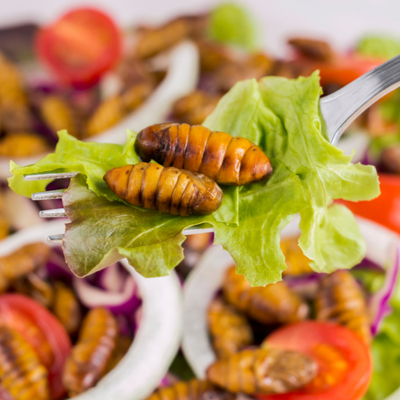
Insect are “food of the future”
Insects as a raw material for food production have long been considered a diet of the future, but we still have prejudice against insects as food. Our ancient ancestors used insects to supply nutrients and even now insects are a standard part of nutrition in several countries. What many people don’t know is that insects are much more sensitive to chemicals than humans, suggesting that insect feed must be as clean as possible – Bio quality.
The insect consumer results in uncontaminated raw materials or food. The consumer is also interested in the possible nutritional benefit of the food. Insects represent a quality animal and easily digestible protein that can be combined with any food or raw material.
Insect flour, which is used in bakery, is gradually coming to the forefront. The most commonly used for gastronomy are processed by the flyfishes (crickets a grasshopper) a cockroaches. Insect farming also contributes to improving the environment.
Advantages of insect breeding:
Unlike conventional livestock production, insect farming is less expensive to invest. For 10-12 tons of annual insect production, only 100 m2 of space is needed, including storage areas
Another big advantage is waste-free management, as insect droppings are agriculturally approved by the Central Inspection and Testing Institute as an excellent organic fertilizer.
Insect production is very environmentally friendly, since it does not smell, is not noisy and, due to its enzymatic digestion, eliminates a minimum amount of methane.
Another significant advantage is the almost 100% utilization of insect production.
Insects are extremely effective in transforming feed into an edible food. Only 2 kilograms of feed are needed per kilogram of insect meat, while cattle need up to 8 kilograms of feed to produce one kilogram of meat.
Insects have minimum requirements for drinking water, receiving it mainly from air humidity and food. Less than 2 liters of water are needed to produce one kilogram of insects. Compared to bovine animals, where water consumption is up to 150 liters per kg, this is a significant saving of this important resource.
It is only a matter of time before the consumer gets used to this nutritionally charged superfood, which is healthy, low-calorie and tastes essentially as the final consumer wishes. Insects do not have a distinct taste, rather none, which gives the consumer the chance to taste the insect protein of his own.
According to the Food and Agriculture Organization of the United Nations, FAO provides insects with high-quality proteins and nutrients and is “extremely important as a food supplement for malnourished children!” It can be rich in iron, magnesium, zinc and other body beneficial substances.
Experts emphasize that we should eat more insects and larvae to protect the climate and the environment.
Meticulous, a market research firm, predicted that the world market for insects for consumption will increase by $ 2023 to $ 1.18 billion, a year-on-year increase of over 20%.
In 2050, up to 9 billion people will need to feed, and this will only be possible if rich nations change animal husbandry and plant cultivation, as well as eating habits.
Traditional livestock farming requires a large area, a lot of water and feed, and the elimination of greenhouse gases produced by livestock warming the climate.





Leave a Reply